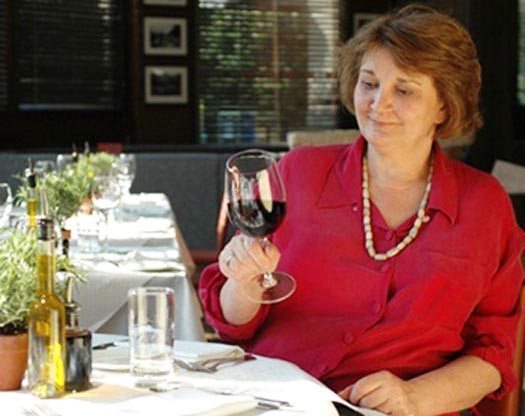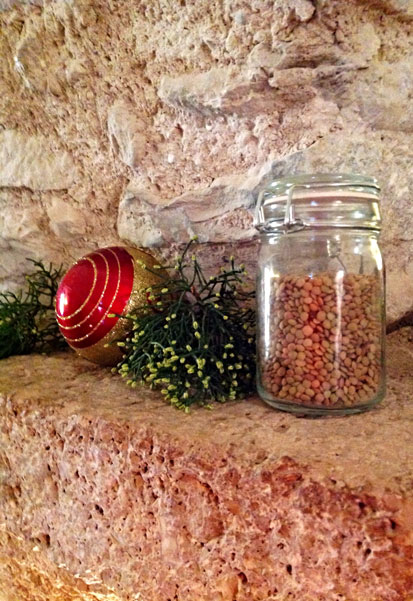Valentina Harris is perhaps our most celebrated and prolific Italian food writer, TV presenter and chef. Yes, the lady truly is Italian, although one could be fooled into thinking she is an authentically British blue-blood.
Valentina Harris doesn’t have many free moments but I cornered her on a return flight from a culinary tour of Umbria. She is an unashamed supporter of the country of her birth, and conducts gastronomic adventures to Umbria and other regions.
 I asked Valentina about her association with the beautiful and mostly undiscovered Umbria. ‘I had never really known Umbria, because coming from Tuscany as I do, and having been to school and then chefs’ school in Rome, Umbria was somewhere we just by-passed on the way between the two.
I asked Valentina about her association with the beautiful and mostly undiscovered Umbria. ‘I had never really known Umbria, because coming from Tuscany as I do, and having been to school and then chefs’ school in Rome, Umbria was somewhere we just by-passed on the way between the two.
‘But a few years ago, at La Dolce Vita in London, the big food and lifestyle association, Umbria was the featured region. I met all these people from Umbria and as a result I went to visit. That was the start of my journey of discovery. Last year I was invited to give the opening speech at the International Festival of Journalism in Perugia (capital of the region), which happens every May. I talked about what I do on my culinary tours, and about how I try and lead those who are not ‘of the place’ to understand, and come to love, Italy through eating the delicious food that each region has to offer. For me it always comes back to that: the reason that Italian food is so interesting, and what makes it so endlessly fascinating, is the fact that there are so many regions, so many different styles of cuisine, and the food, whilst it remains so fundamental to all Italian life, cannot be described as just ‘Italian’ food – not by Italians nor anybody else – you have to look at it on a regional basis.
‘By bringing people to individual regions, to stay and to cook and to eat and to explore and to have a culinary adventure, they leave with a greater understanding, I think, than if they had just wandered around shopping and looking at churches and lying on a beach. The ‘menù turistico’, the ubiquitous tourist menu, never has any regional basis, and I’m worried that there are lots of people who come to Italy and never experience the local cuisine. Through local dishes you can learn all about the people, the sociology, the geography, the history, the culinary traditions – all of those things are very revelatory, if you just stop to think for a minute.
 ‘So I made this speech, and it obviously hit a lot of the right notes in the tourist authorities, who are very keen to bring the British and others to discover more about Umbria, so they invited me to start running press trips, of which this is the first one. It’s called an ‘educatour’. There is another one planned for carnival time in February. I’ve worked with the tourist board and other authorities to create a balance of food, wine, a little bit of culture, a little free time; and of course on this one we all wanted to go Christmas shopping – what an opportunity with just a couple of weeks to go. So many lovely things to take home, from a fresh truffle to a bar of chocolate.
‘So I made this speech, and it obviously hit a lot of the right notes in the tourist authorities, who are very keen to bring the British and others to discover more about Umbria, so they invited me to start running press trips, of which this is the first one. It’s called an ‘educatour’. There is another one planned for carnival time in February. I’ve worked with the tourist board and other authorities to create a balance of food, wine, a little bit of culture, a little free time; and of course on this one we all wanted to go Christmas shopping – what an opportunity with just a couple of weeks to go. So many lovely things to take home, from a fresh truffle to a bar of chocolate.
‘We witnessed for ourselves in Norcia (the black truffle and cured pork capital of Umbria) the Benedictine monks, and their prayer schedule is endless: they are up at 4.30 in the morning, still finding time to brew beer, run a shop, and there’s only a handful of them. We were fortunate enough to listen to the chanting, and to see a novice being inducted into the order.
Umbrian food is very exciting in its own way, but it has a slightly spartan quality about it. Look at the ingredients of the region: first you have the lentil – which has never floated anyone’s boat, but this is a particularly delicious lentil with a very fine skin, that cooks quickly and is very digestible, and it is venerated. (I use that word because that is how they talk about their food, in the same way that a saint is venerated.) If you think that the lentil is all there is on the ‘pulse’ front you’d be mistaken, because there is a vast range of other beans and lentils and wild peas that are not common anywhere else. It reflects a cuisine that is very humble and simple, but they will take these legumes and pulses, cook them and serve them with their unbelievably delicious olive oil, reputedly the very best olive oil in Italy.
We have the lentil and the olive oil; then we have two extraordinary luxuries: chocolate and truffles – amazing in the middle of all this low-key, no-frills cuisine! Perugia is the ‘other’ centre of chocolate in Italy: Torino, Modica in Sicily, and then there is Perugia.
‘The other great ingredient of the region is pork: ham, salami, sausages, coppa (cured meat from the neck of the pig), and guanciale (bacon from the jowl). The pig that they favour is the little ‘cinta senese’ or belted pig from Siena. The meat is very lean and fragrant, and they run wild and eat acorns. Norcia is the centre of the butchering and curing of this meat.
‘We haven’t mentioned the cheese: it’s not really a region of dairy cows, and Italians generally, apart from down south, have a resistance to eating lamb and mutton. The sheep that you see in the area are mainly kept for their wool and for their milk to make pecorino cheese – softer as a table cheese, turning harder and more granular as it ages into a grating cheese. And of course it’s delicious with a bit of truffle!
‘Everywhere out in the country, far away from a ‘supply chain’, mountainous and without flat areas on which to grow things, has a tradition of foraging. You pick up wild mushrooms in the woodlands, and also dandelions, bitter greens, nettles (a spinach substitute) – it’s an old practice and a very relaxing thing to do, going out with your basket and bringing home some food. Obviously you have to know what you are doing, you don’t want to throw in a handful of deadly nightshade or the like. But it seems to be something handed down from father to son.
 ‘I always take my groups on a truffle hunt. A very dear friend, Sergio, now in his 70s, is one of the loveliest people I have ever met. He invested in some truffle trees – a tree where the roots have been injected with truffle spores. You plant these trees and hope for the best. You wait six years, then suddenly you might notice an intense garlic smell, and you will find a ‘signal’ truffle just under the soil. This one isn’t really edible, but it tells you that the truffle has taken root. You then have to wait another couple of winters, and you start training your dog. You train them on garlic, so they associate the smell with food. Of course the dog will try to eat it, so you have to be right there and the dog has to answer your command to leave it and sit until you pick it up. If a truffle has bite marks on it, it isn’t going to sell as well as a nice smooth one! So we visit Sergio and he is so ‘chuffed’ that his investment has paid off. He now grows truffles around the year, supplies the local restaurants and hotels, and it’s good fun – but it’s real life.’
‘I always take my groups on a truffle hunt. A very dear friend, Sergio, now in his 70s, is one of the loveliest people I have ever met. He invested in some truffle trees – a tree where the roots have been injected with truffle spores. You plant these trees and hope for the best. You wait six years, then suddenly you might notice an intense garlic smell, and you will find a ‘signal’ truffle just under the soil. This one isn’t really edible, but it tells you that the truffle has taken root. You then have to wait another couple of winters, and you start training your dog. You train them on garlic, so they associate the smell with food. Of course the dog will try to eat it, so you have to be right there and the dog has to answer your command to leave it and sit until you pick it up. If a truffle has bite marks on it, it isn’t going to sell as well as a nice smooth one! So we visit Sergio and he is so ‘chuffed’ that his investment has paid off. He now grows truffles around the year, supplies the local restaurants and hotels, and it’s good fun – but it’s real life.’
I asked Valentina how many regions her tours might cover in future.
‘I think Umbria is a good one, particularly because I think that the ‘staying in a lovely house, eating on the balcony and doing a bit of cooking’ has been done now. It’s lovely, I’m not saying that it’s not a pleasant experience, but what I have in mind, and what I’m going to be doing from now, is different. I have a link with the Università dei Sapori (UDS) in Perugia, a state-run university dedicated to catering and food, and in particular the food and wines of Umbria. I am going to be offering a tour of Umbria, staying in beautiful places, showing the romance of Umbria, the architecture, the countryside, then putting it into practice, staying possibly on-campus (the accommodation is at least 3-star if not 4) and using the kitchen facilities at UDS which are extraordinary – as professional as you can get.
‘I am now an ambassador for UDS in the UK, and I want to bring students who are studying professionally, but also keen amateurs, the Masterchef-watchers, the foodie who wants the latest technique and knife and exotic ingredient, and combine the two. Relaxing, wandering round the vineyards, going out to fabulous lunches, going to the markets – and then working with those ingredients for 2 or 3 days. It’s a great joy to cook in a professional kitchen, if you’ve never experienced it. It’s a bit like going back to kindergarten: you are allowed to make as much mess as you like, spread out, everybody has their own station, their own stove, there are lots of kitchen porters to help you, and the ingredients are second-to-none. There is a laboratory devoted entirely to Italian ice cream, and one could spend a day playing with this fantastic kit making fabulous ice cream.
 ‘I am selling a unique and very special product, with all my love and passion – 5-star without the fuss. I will do two spring/summer and two late summer/autumn tours in Umbria, then I’d like to revisit the south of Italy, because we need to remind people of the healthy ‘Mediterranean diet’. It’s as much about sitting around the table, talking, the convivial thing, rather than eating while staring at the TV screen, or standing up with your Blackberry in your hand. They eat very little animal fat, lots of fruit and vegetables, legumes, carbohydrates, lots of fresh fish.
‘I am selling a unique and very special product, with all my love and passion – 5-star without the fuss. I will do two spring/summer and two late summer/autumn tours in Umbria, then I’d like to revisit the south of Italy, because we need to remind people of the healthy ‘Mediterranean diet’. It’s as much about sitting around the table, talking, the convivial thing, rather than eating while staring at the TV screen, or standing up with your Blackberry in your hand. They eat very little animal fat, lots of fruit and vegetables, legumes, carbohydrates, lots of fresh fish.
‘I’d like to do something by the sea, as a contrast to the mountainous inland food – plenty of fresh fish, citrus fruits, salads, tomatoes. My knowledge of all the regions of Italy is as a result of learning: I wasn’t born with it, I’ve studied a lot, travelled a lot, talked to a lot of people, read a lot of books, and I feel confident enough to take people wherever they want to go. If someone said “Can you organise a bespoke tour in, say, Rome or Venice?” I could do that. The point is that you will leave with a greater appreciation, and hopefully a love of Italy, and you’ll want to come back – and tell your friends about it.’
Valentina’s success as a gastronomic tour organiser, leader, coach, hand-holder is assured. A couple of days in her company show this lady in action. She is blessed by being bi-lingual, sounding like a local in both the UK and Italy. She has an easy rapport with owners of vineyards, hotels, restaurants and cookery schools. She is a trained chef and is equipped to answer food-related questions. She is Italian and can give a first-hand insight into culture, custom and practice. She is amusing, talented and will ensure that any tour will leave the participants fulfilled …and feeling full.
To learn more about Valentina Harris and her gastronomic tours visit here.
Travel review by Chrissie Walker © 2018
Read more about Valentina Harris here
Read more articles about Italy here
